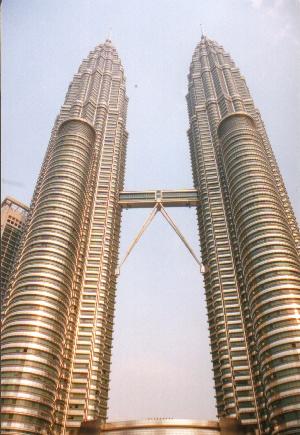
Malaysia

An introduction to the geography, economy and people of Malaysia.
Malaysia Facts
Malaysia has a tropical climate, which is hot, humid and wet. It is geographically divided into two parts, East and West Malaysia (East Malaysia consisting of (starting from the north) Sabah and Sarawak and West Malaysia consisting of (anticlockwise direction from northwest) Perlis, Kedah, Perak, Selangor, Negri Sembilan, Malacca, Johor). The capital city of Malaysia is Kuala Lumpur (KL). Its land area is about 329,750 km² and its coastline is 4,675 km long . Natural disasters rarely occur here except for some flooding and landslides. Most of Malaysia's land (about 68%) is forested. Coastal plains rise to mountains further from the sea. Mount Kinabalu (4,100 m) in Sabah is the highest mountain. Natural resources in Malaysia are tin, petroleum, timber, copper, iron ore, natural gas, bauxite. Environmental issues in Malaysia are air pollution from industrial and vehical emissions, water pollution from raw sewage, deforestation and the haze from Indonesian forest fires in Sumatra. Major cities in Malaysia are Kuala Lumpur (KL), Alor Star, Ipoh, Kota Bahru, Kuala Trengganu, Kuantan, Johor Bahru, Malacca and Georgetown.
Malaysia is a constitutional monarchy. Malaya (what is now Peninsular or West Malaysia) was formed on the 31st of August 1957. The Federation of Malaysia (Malaya, Sabah, Sarawak, and Singapore) was formed on the 9th of July 1963 (Singapore left the federation on the 9th of August 1965). Malaysia is nominally headed by the paramount ruler and a bicameral Parliament consisting of a nonelected upper house and an elected lower house. Peninsular Malaysian states have hereditary rulers in all but Melacca, Penang, Sabah, and Sarawak, where governors are appointed by the Malaysian Government. The powers of the state governments are limited by the federal constitution. Under the terms of the federation, Sabah and Sarawak retain certain autonomy (such as the right to maintain their own immigration controls). Sabah holds 20 seats in House of Representatives, with foreign affairs, defense, internal security, and other powers delegated to federal government. Sarawak holds 28 seats in the Malaysian House of Representatives, with foreign affairs, defense, internal security, and other powers left to the federal government in KL. The Prime Minister of Malaysia is Dr. Mahathir bin Mohamad and the Deputy Prime Minister is Abdullah bin Ahmad Badawi. Law in Malaysia is based on English law. Paramount Ruler Sultan Tunku Salahuddin Abdul Aziz Shah ibni Al-Marhum Sultan Hisammuddin Alam Shah is the head of state and the Deputy Paramount Ruler Sultan Mizan Zainal Abidin ibni A-Marhum Sultan Mahmud Al-Muktafi Billah Shah. Malaysia has a unique system for choosing the head of state - every five years, the monarch changes and the position rotates among the sultans of Malaysia.
Malaysia is regarded by some to be one of the next Asian Newly Industrialising
Countries (NICs). It is also one of the largest exporters of palm oil.
The Petronas Twin Towers (below) are the tallest in the world.
Malaysia made a quick economic recovery in 1999 from its worst
recession since its independence. Gross Domestic Product (GDP) grew 5%,
responding to Malaysia's dynamic export sector, which grew over 10% and stimulus
from higher government spending. The large export surplus has enabled Malaysia
to build up its substantial financial reserves to $31 billion at 1999. This
stable macroeconomic environment, in which both inflation and unemployment stand
at 3% or less, has made possible the relaxation of most of the capital (monetary)
controls imposed by the government in 1998 to counter the impact of the
financial crisis. However, the ringgit (Malaysia's currency) remains pegged to
the US$ at about 3.78 ringgit to 1 dollar. Malaysia's government and many
analysts expect Malaysia to continue the trend into 2000 and predict GDP will
grow another 5%. While Malaysia's short-term economic future looks bright, its
long-term prospects are clouded by the lack of reforms in the corporate sector,
particularly those dealing with competitiveness and high corporate debt.

The population of Malaysia is about 21,800,000 and the population growth rate is about 2%. Life expectancy is around 71 years at birth. Malaysia is mainly Malay and other indigenous groups (bumiputras) (62%) and Chinese (26%). Indians make up 7% and others 9%. the main religions in Malaysia are Islam, Buddhism, Taoism, Hinduism, Christianity and Sikhism, but some Shamanism is practiced in East Malaysia (Sabah and Sarawak). Languages spoken in Malaysia are Bahasa Melayu (Malay) (official) (note: in Malay, 'c' is pronounced 'ch'), English, Chinese and Chinese dialects, Tamil, Telugu, Malayalam, Punjabi and Thai. In East Malaysia several indigenous languages are spoken, the largest of which are Iban and Kadazan. The literacy of the total population is 83.5%.
Ideally, this website should be viewed using Internet Explorer 5.